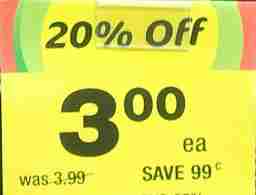The above is a picture of the chocolate display at Woolworths, an Australian supermarket that was formerly known as Safeway – it had the same logo as the US Safeway so there’s probably a connection. This is actually a 24.81% discount. It’s possible that some people might consider it a legal issue to advertise something as a 25% discount when it’s 1 cent short of that (even though we haven’t had a coin smaller than 5 cents in Australia since 1991). But then if they wanted to advertise a discount percentage that’s a multiple of 5% they could have made the discount price $2.99, presumably whatever factors made them make the original price $3.99 instead of $4.00 would also apply when choosing a discount price.
So the question is, do Woolworths have a strict policy of rounding down discount rates to the nearest 5% or do they just employ people who failed maths in high school?
Sometimes when discussing education people ask rhetorical questions such as “when would someone use calculus in real life”, I think that the best answer is “people who have studied calculus probably won’t write such stupid signs”. Sure the claimed discount is technically correct as they don’t say “no more than 20% off” and not misleading in a legal sense (it’s OK to claim less than you provide), but it’s annoyingly wrong. Well educated people don’t do that sort of thing.
As an aside, the chocolate in question is Green and Black, that’s a premium chocolate line that is Fair Trade, Organic, and very tasty. If you are in Australia then I recommend buying some because $3.00 is a good price.


* you’re still supposed to account in cents, then round if they’re paying in cash at the end (over 100 items it could add up to… not very much) -> NZ doesn’t even have 5c coins!
* understating a discount is probably misleading, but anyone misled won’t suffer loss.
* +1 Green and Black
I have noticed this repeatedly over the past few months. Also, Coles does the same thing, especially on the “buy x for $y” type signs, and their math is off much larger amounts.
Funny that you have retail prices with a one cent precision, while you have no coin under five cents.
We used to have no coin under five cents in France too when we were still using francs, but then our prices, including the psychological prices, e.g. FF 5.95, except for one worth-noting exception: gas, which had a price per litre with a cent precision.
Actually, now that we are using euros, we do have a one cent coin, so our prices use a one cent precision. Except for the gas too, which has a one thouthandth precision!
Isn’t it advertised as a 20% discount, which makes the problem go away ? (unless someone complains that they are getting more discount that what was advertised).
According to Wikipedia, there is indeed a connection: https://en.wikipedia.org/wiki/Safeway_%28Australia%29
Elessar: It seems that most people pay by EFTPOS at the supermarket, so even without 1c coins it’s possible to pay in 1c increments. Also if you buy 5 items then the total price can be paid exactly in cash.
In Australia we have a 0.1 cent precision on petrol prices. Are you really saying that you have a 0.001 cent precision on petrol prices in France?
Frédéric: It’s just wrong, they should use better precision. The fact that people won’t (and can’t) complain about getting a bigger discount isn’t the issue. The issue is that their mathematical failing annoys me. Thanks for the link about Safeway.
OT: I can recommend the Oxfam chocolate with coffee nibs, available at La Manna and I suppose elsewhere.